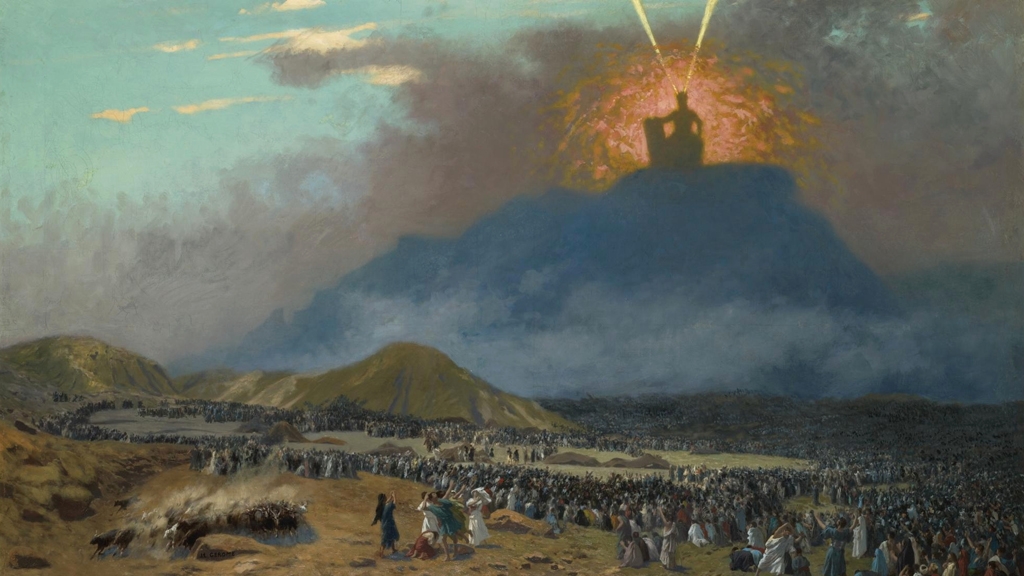What is most likely the earliest talmudic statement on the date of the revelation on Mount Sinai may be found in the talmudic tractate of Shabbat (86b). According to the calculations of the sages, the Jews left Egypt on Friday, the 15th of Nisan. The Torah was given on Saturday, the sixth of Sivan, which was the equivalent of the 50th day of the omer, the day on which Shavuot was permanently fixed in the Scriptures.
Rabbi Jose, a second century sage, offers a dissenting view. He states that the Jews left Egypt on Thursday, the 15th of Nisan, and that the Law was given on Saturday, the seventh of Sivan. Interestingly, the ecclesiastic calendar of the Book of Jubilees corroborates Rabbi Jose’s date of the giving of the Law.
The author of Magen Avraham (Orach Chayim 494) points out that the seventh day of Sivan was the equivalent of the 51st day of the omer, one day after the fixed day of Shavuot. Consequently, Shavuot could not mark the anniversary of the Law.
Shavuot in the Talmud
The first step in the development of Shavuot after the exile was the official establishment of the date of the revelation on Mount Sinai. The date indicated by the ancient sages was the sixth of Sivan, which was accepted by the majority of rabbis. One of the first official rabbinic texts to connect the giving of the Torah with Shavuot was a passage in the Midrash [commentary], Exodus Rabbah, chapter 31, attributed to Rabbi Meir. Here, mention is made of the “Festival of the Harvest on which the Torah was given to Israel.”
An entire talmudic tractate, called Bikkurim, deals with the offerings of first fruits in the Temple. The Mishnah of Bikkurim 1:6 states that the period for bringing the first fruits was any time from Shavuot to Sukkot. The villagers would first assemble in the large town of the district and would go up together with their first ripe fruits to the Temple where they would be welcomed with song by the Levites. The Mishnah of Bikkurim (chapter 3) graphically describes the scene:
At the rise of morning an official says, ‘Rise and let us go up to Zion, to the House of the Lord our God.’ An ox walked before them, its horns covered with gold, and with an olive crown on its head. The halil (flute) was played before them till they reached the vicinity of Jerusalem. Upon coming close to Jerusalem, they sent word ahead and decorated their bikkurim. The important officials went out to meet them…and all the tradesmen in Jerusalem stood before them and greeted them, ‘Our brothers, the men of such and such a place, you have come in peace.’
The flute was played before them till they reached the Temple Mount. Even King Agripas took the basket on his shoulders and carried it till he reached the courtyard. When the pilgrims reached the courtyard, the Levites sang, ‘I will exalt You, O God, for You have saved me and You have not rejoiced my enemies over me.
With the basket still on his shoulder, the Israelite read, ‘I have told the Lord your God this day that I have come to this land that the Lord swore to our fathers to give us. My father was a wandering Aramean and he went down to Egypt and he sojourned there and he became there a great, mighty, and numerous people. And the Egyptians harmed us, and they afflicted us and they put hard labor upon us, and we cried out to the Lord, the God of our fathers, and the Lord heard our voice, and the Lord took us out from Egypt with a strong hand…and God brought us to this place, and God gave us this land, a land flowing with milk and honey. And now, I bring the first fruits of the land that you have given me, O God.’ After completing the entire parashah [portion], the Jew places the bikkurim basket by the side of the altar, he bows down and goes out.
The High Priest then acts on behalf of the people as a whole, presenting before the altar the special Shavuot wave-offering, two loaves of bread made of wheat, the first products of the spring wheat harvest that begins just as the barley harvest comes to an end. Thus Shavuot in …[second temple] times celebrated the bounty of the spring harvest season.
The Festival is Transformed
In rabbinic times, a remarkable transformation of the festival took place. Based on the verse “In the third month after the children of Israel were gone forth out of the land of Egypt, the same day they came into the wilderness of Sinai,” [Exodus 19:1] the festival of Shavuot became the anniversary of the giving of the Torah at Sinai.
Although Shavuot was known in the Bible by several names, including the Feast of the Harvest, the Festival of Weeks, and the Festival of the First Fruits, the sages added the name “Atzeret“– withdrawal. In the Torah, the last days of the two other pilgrimage festivals (Passover and Sukkot) are referred to as Atzeret to indicate on the seventh day of Passover and on the eighth day after the beginning of Sukkot, there must be a withdrawal from all menial labor.
Shavuot, too, was given the name of Atzeret by the Rabbis so as to emphasize the necessity of abstaining from menial labor on this holiday as well. In fact, for this reason, the sages referred to Shavuot by the name Atzeret almost exclusively. They refused to adopt the theme of “Giving the Torah” in assigning a name to the festival, because in their thinking it would be sacrilegious to limit the celebration of the giving of the Torah to a single day. To them, every day of the year should be considered as a day of receiving the Torah anew.
Excerpted with permission from Every Person’s Guide to Shavuot (Jason Aronson, Inc).
Avraham
Pronounced: AHVR-rah-ham, Origin: Hebrew, Abraham in the Torah, considered the first Jew.
Mishnah
Pronounced: MISH-nuh, Origin: Hebrew, code of Jewish law compiled in the first centuries of the Common Era. Together with the Gemara, it makes up the Talmud.
Shabbat
Pronounced: shuh-BAHT or shah-BAHT, Origin: Hebrew, the Sabbath, from sundown Friday to sundown Saturday.
Shavuot
Pronounced: shah-voo-OTE (oo as in boot), also shah-VOO-us, Origin: Hebrew, the holiday celebrating the giving of the Torah at Mount Sinai, falls in the Hebrew month Sivan, which usually coincides with May or June.
Sivan
Pronounced: see-VAHN, Origin: Hebrew, Jewish month, usually coinciding with May-June.
Torah
Pronunced: TORE-uh, Origin: Hebrew, the Five Books of Moses.



